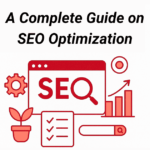The Ultimate Guide to SEO 2025: Everything You Need to Know
Search Engine Optimization (SEO), a type of digital marketing, is the process of improving a website’s visibility on search engines like Google, Bing, and Yahoo to drive organic traffic. With millions of websites competing for attention, SEO is essential for businesses and individuals looking to increase online visibility.
In this guide, we will break down everything about SEO, including its types, strategies, best practices, and key ranking factors.
What is SEO and Why is it Important?
SEO is the practice of optimizing a website’s content, structure, and authority to improve its rankings on search engine results pages (SERPs). A well-optimized website:
- Drives more organic traffic (free traffic from search engines).
- Increases brand credibility and authority.
- Improves user experience (UX) and site usability.
- Generates more leads and conversions.
Since Google processes over 8.5 billion searches per day, ranking on the first page can bring huge business opportunities.
Types of SEO
SEO is divided into three main categories:
1. On-Page SEO
On-page SEO refers to optimizations made directly on a website to improve rankings. It includes:
- Keyword Optimization – Using primary and LSI (Latent Semantic Indexing) keywords naturally in content.
- Title Tags & Meta Descriptions – Crafting compelling title tags and meta descriptions with target keywords.
- Header Tags (H1, H2, H3, etc.) – Organizing content with proper headings for readability.
- Internal Linking – Connecting pages within a website to enhance navigation.
- Image Optimization – Using alt text, proper file names, and compressed images for faster loading.
- URL Structure – Creating clean, keyword-rich URLs.
Example of an optimized URL:
❌ example.com/p=12345
✅ example.com/seo-best-practices
2. Off-Page SEO
Off-page SEO involves activities outside your website to boost its authority and rankings. It includes:
- Backlink Building – Getting high-quality backlinks from authoritative sites.
- Guest Blogging – Writing content for relevant industry websites.
- Social Media Engagement – Sharing content on Facebook, LinkedIn, Twitter, and Instagram.
- Brand Mentions – Gaining mentions on forums, directories, and review sites.
- Influencer Outreach – Partnering with influencers for brand exposure.
Example of a High-Authority Backlink Strategy:
- Get featured on Forbes, HubSpot, or industry blogs.
- Contribute to Quora, Medium, and Reddit discussions.
3. Technical SEO
Technical SEO ensures search engines can crawl, index, and understand a website effectively. It includes:
- Website Speed Optimization – Reducing load times using caching, compression, and optimized images.
- Mobile-Friendliness – Ensuring a responsive design for all devices.
- XML Sitemap & Robots.txt – Helping search engines understand the site structure.
- SSL Certificate (HTTPS) – Securing the site for better rankings.
- Fixing Broken Links & Redirects – Avoiding 404 errors and unnecessary redirects.
How Search Engines Work
Understanding how search engines work is essential for SEO success. Google follows three main steps:
- Crawling – Google bots (spiders) scan the web for new and updated pages.
- Indexing – Pages are stored in Google’s database for future retrieval.
- Ranking – Google ranks pages based on over 200 ranking factors, including content quality, backlinks, and user experience.
Google Algorithm Changes
Being a popular search engine, Google frequently updates its algorithm to improve search results. Some major updates include:
- Panda Update – Penalized low-quality content and keyword stuffing.
- Penguin Update – Focused on spammy backlinks.
- Mobile-First Indexing – Prioritizes mobile-friendly sites.
- Core Web Vitals – Measures user experience (page speed, interactivity, and visual stability).
Key SEO Ranking Factors
Google uses multiple factors to rank websites, including:
1. High-Quality Content
- Content must be informative, engaging, and original.
- Use long-form content (1,000+ words) for in-depth information.
- Add multimedia elements (images, videos, infographics).
2. Keyword Research & Optimization
- Use primary and secondary keywords naturally.
- Include long-tail keywords to target specific searches.
- Avoid keyword stuffing, which can lead to penalties.
3. Backlinks & Domain Authority
- Websites with high-authority backlinks rank higher.
- Focus on quality over quantity (one backlink from Forbes is better than 100 low-quality links).
4. User Experience (UX) & Page Speed
- Fast-loading websites rank better (aim for under 3 seconds).
- Ensure easy navigation and clear CTAs (Call-to-Actions).
- Optimize for mobile users, as Google prioritizes mobile-first indexing.
5. Technical SEO & Site Structure
- Ensure a clean, well-organized site hierarchy.
- Fix broken links, 404 errors, and duplicate content.
- Use structured data (schema markup) for rich snippets.
SEO Strategies for Higher Rankings
1. Local SEO for Small Businesses
- Optimize Google My Business (GMB) profile.
- Get local citations from directories like Yelp and YellowPages.
- Encourage customer reviews for credibility.
2. Voice Search Optimization
- Use conversational long-tail keywords (e.g., “best coffee shop near me”).
- Optimize for question-based searches (“how, what, where, why”).
3. Featured Snippets Optimization
- Structure content in Q&A format.
- Use bullet points and numbered lists for easy readability.
- Optimize content for Google’s “People Also Ask” section.
4. Video SEO
- Optimize YouTube videos with keywords in titles and descriptions.
- Use closed captions and transcripts for better accessibility.
- Embed videos on your website to increase engagement.
SEO Tools to Improve Performance
Using SEO tools can help track and improve performance. Some essential tools include:
- Google Search Console – Monitors indexing, errors, and search queries.
- Google Analytics – Tracks website traffic and user behavior.
- Ahrefs & SEMrush – Analyzes backlinks, keywords, and competitors.
- Yoast SEO – Helps optimize WordPress content.
- Moz & Ubersuggest – Provides keyword insights and site audits.
Common SEO Mistakes to Avoid
- Ignoring Mobile Optimization – Non-responsive websites rank lower.
- Using Duplicate Content – Leads to Google penalties.
- Neglecting Backlink Quality – Spammy backlinks harm rankings.
- Not Updating Content Regularly – Fresh content ranks better.
- Ignoring Page Speed – Slow websites experience higher bounce rates.
Conclusion
SEO is an ongoing process that requires strategic planning, consistent effort, and regular updates. By focusing on on-page, off-page, and technical SEO, you can improve your website’s rankings and drive organic traffic.
Want to boost your website’s search engine optimization? Start implementing these strategies today, and watch your rankings climb in search results!



